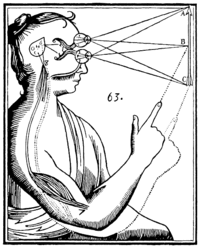In philosophy, emergentism is the belief in emergence, particularly as it involves consciousness and the philosophy of mind, and as it contrasts with and also does not contrast with reductionism. A property of a system is said to be emergent if it is a new outcome of some other properties of the system and their interaction, while it is itself different from them. Emergent properties are not identical with, reducible to, or deducible from the other properties. The different ways in which this independence requirement can be satisfied lead to variant types of emergence.
Forms
All varieties of emergentism strive to be compatible with physicalism, the theory that the universe is composed exclusively of physical entities, and in particular with the evidence relating changes in the brain with changes in mental functioning. Many forms of emergentism, including proponents of complex adaptive systems, do not hold a material but rather a relational or processual view of the universe. Furthermore, they view mind–body dualism as a conceptual error insofar as mind and body are merely different types of relationships. As a theory of mind (which it is not always), emergentism differs from idealism, eliminative materialism, identity theories, neutral monism, panpsychism, and substance dualism, whilst being closely associated with property dualism. It is generally not obvious whether an emergent theory of mind embraces mental causation or must be considered epiphenomenal.
Some varieties of emergentism are not specifically concerned with the mind–body problem, and instead suggest a hierarchical or layered view of the whole of nature, with the layers arranged in terms of increasing complexity with each requiring its own special science. Typically physics (mathematical physics, particle physics, and classical physics) is basic, with chemistry built on top of it, then biology, psychology, and social sciences. Reductionists respond that the arrangement of the sciences is a matter of convenience, and that chemistry is derivable from physics (and so forth) in principle, an argument which gained force after the establishment of a quantum-mechanical basis for chemistry.
Other varieties see mind or consciousness as specifically and anomalously requiring emergentist explanation, and therefore constitute a family of positions in the philosophy of mind. Douglas Hofstadter summarises this view as "the soul is more than the sum of its parts". A number of philosophers have offered the argument that qualia constitute the hard problem of consciousness, and resist reductive explanation in a way that all other phenomena do not. In contrast, reductionists generally see the task of accounting for the possibly atypical properties of mind and of living things as a matter of showing that, contrary to appearances, such properties are indeed fully accountable in terms of the properties of the basic constituents of nature and therefore in no way genuinely atypical.
Intermediate positions are possible: for instance, some emergentists hold that emergence is neither universal nor restricted to consciousness, but applies to (for instance) living creatures, or self-organising systems, or complex systems.
Some philosophers hold that emergent properties causally interact with more fundamental levels, an idea known as downward causation. Others maintain that higher-order properties simply supervene over lower levels without direct causal interaction.
All the cases so far discussed have been synchronic, i.e. the emergent property exists simultaneously with its basis. Yet another variation operates diachronically. Emergentists of this type believe that genuinely novel properties can come into being, without being accountable in terms of the preceding history of the universe. (Contrast with indeterminism where it is only the arrangement or configuration of matter that is unaccountable). These evolution-inspired theories often have a theological aspect, as in the process philosophy of Alfred North Whitehead and Charles Hartshorne.
Relationship to vitalism
A refinement of vitalism may be recognized in contemporary molecular histology in the proposal that some key organising and structuring features of organisms, perhaps including even life itself, are examples of emergent processes; those in which a complexity arises, out of interacting chemical processes forming interconnected feedback cycles, that cannot fully be described in terms of those processes since the system as a whole has properties that the constituent reactions lack.
Whether emergent system properties should be grouped with traditional vitalist concepts is a matter of semantic controversy. In a light-hearted millennial vein, Kirshner and Michison call research into integrated cell and organismal physiology “molecular vitalism.”
According to Emmeche et al. (1997):
"On the one hand, many scientists and philosophers regard emergence as having only a pseudo-scientific status. On the other hand, new developments in physics, biology, psychology, and crossdisciplinary fields such as cognitive science, artificial life, and the study of non-linear dynamical systems have focused strongly on the high level 'collective behaviour' of complex systems, which is often said to be truly emergent, and the term is increasingly used to characterize such systems."
Emmeche et al. (1998) state that "there is a very important difference between the vitalists and the emergentists: the vitalist's creative forces were relevant only in organic substances, not in inorganic matter. Emergence hence is creation of new properties regardless of the substance involved." "The assumption of an extra-physical vitalis (vital force, entelechy, élan vital, etc.), as formulated in most forms (old or new) of vitalism, is usually without any genuine explanatory power. It has served altogether too often as an intellectual tranquilizer or verbal sedative—stifling scientific inquiry rather than encouraging it to proceed in new directions."
In The Conscious Mind (1996) David Chalmers argues that comparisons between vitalism and the "hard problem of consciousness" commit a category error, because - unlike life - consciousness is irreducible and lower order physical facts. It is logically impossible that one could perfectly replicate all the lower order facts of, say, wombat cellular biology without the higher order facts about the wombat coming along for the ride. In contrast, it is logically possible that one all the physical facts of the world could be the same without consciousness ever coming into the question (i.e. philosophical zombies). By Chalmers account, facts about consciousness are "further facts about the world in addition to the physical facts." Chalmers concludes that consciousness is a fundamental fact of nature, and thus has no need to emerge out of anything.
History
John Stuart Mill
John Stuart Mill outlined his version of emergentism in System of Logic (1843). Mill argued that the properties of some physical systems, such as those in which dynamic forces combine to produce simple motions, are subject to a law of nature he called the "Composition of Causes". According to Mill, emergent properties are not subject to this law, but instead amount to more than the sums of the properties of their parts.
Mill believed that various chemical reactions (poorly understood in his time) could provide examples of emergent properties, although some critics believe that modern physical chemistry has shown that these reactions can be given satisfactory reductionist explanations. For instance, it has been claimed by Dirac that the whole of chemistry is, in principle, contained in the Schrödinger equation.
C. D. Broad
British philosopher C. D. Broad defended a realistic epistemology in The Mind and its Place in Nature (1925) arguing that emergent materialism is the most likely solution to the mind–body problem.
Broad defined emergence as follows:
Put in abstract terms the emergent theory asserts that there are certain wholes, composed (say) of constituents A, B, and C in a relation R to each other; that all wholes composed of constituents of the same kind as A, B, and C in relations of the same kind as R have certain characteristic properties; that A, B, and C are capable of occurring in other kinds of complex where the relation is not of the same kind as R; and that the characteristic properties of the whole R(A, B, C) cannot, even in theory, be deduced from the most complete knowledge of the properties of A, B, and C in isolation or in other wholes which are not of the form R(A, B, C).
This definition amounted to the claim that mental properties would count as emergent if and only if philosophical zombies were metaphysically possible. Many philosophers take this position to be inconsistent with some formulations of psychophysical supervenience.
C. Lloyd Morgan and Samuel Alexander
Samuel Alexander's views on emergentism, argued in Space, Time, and Deity (1920), were inspired in part by the ideas in psychologist C. Lloyd Morgan's Emergent Evolution. Alexander believed that emergence was fundamentally inexplicable, and that emergentism was simply a "brute empirical fact":
"The higher quality emerges from the lower level of existence and has its roots therein, but it emerges therefrom, and it does not belong to that level, but constitutes its possessor a new order of existent with its special laws of behaviour. The existence of emergent qualities thus described is something to be noted, as some would say, under the compulsion of brute empirical fact, or, as I should prefer to say in less harsh terms, to be accepted with the “natural piety” of the investigator. It admits no explanation." (Space, Time, and Deity)
Despite the causal and explanatory gap between the phenomena on different levels, Alexander held that emergent qualities were not epiphenomenal. His view can perhaps best be described as a form of non-reductive physicalism (NRP) or supervenience theory.
Ludwig von Bertalanffy
Ludwig von Bertalanffy founded general systems theory (GST), which is a more contemporary approach to emergentism. A popularization of many of the elements of GST may be found in The Web of Life by Fritjof Capra.
Jaegwon Kim
Addressing emergentism (under the guise of non-reductive physicalism) as a solution to the mind–body problem Jaegwon Kim has raised an objection based on causal closure and overdetermination.
Emergentism strives to be compatible with physicalism, and physicalism, according to Kim, has a principle of causal closure according to which every physical event is fully accountable in terms of physical causes. This seems to leave no "room" for mental causation to operate. If our bodily movements were caused by the preceding state of our bodies and our decisions and intentions, they would be overdetermined. Mental causation in this sense is not the same as free will, but is only the claim that mental states are causally relevant. If emergentists respond by abandoning the idea of mental causation, their position becomes a form of epiphenomenalism.
In detail: he proposes (using the chart on the right) that M1 causes M2 (these are mental events) and P1 causes P2 (these are physical events). P1 realises M1 and P2 realises M2. However M1 does not causally effect P1 (i.e., M1 is a consequent event of P1). If P1 causes P2, and M1 is a result of P1, then M2 is a result of P2. He says that the only alternatives to this problem is to accept dualism (where the mental events are independent of the physical events) or eliminativism (where the mental events do not exist).




